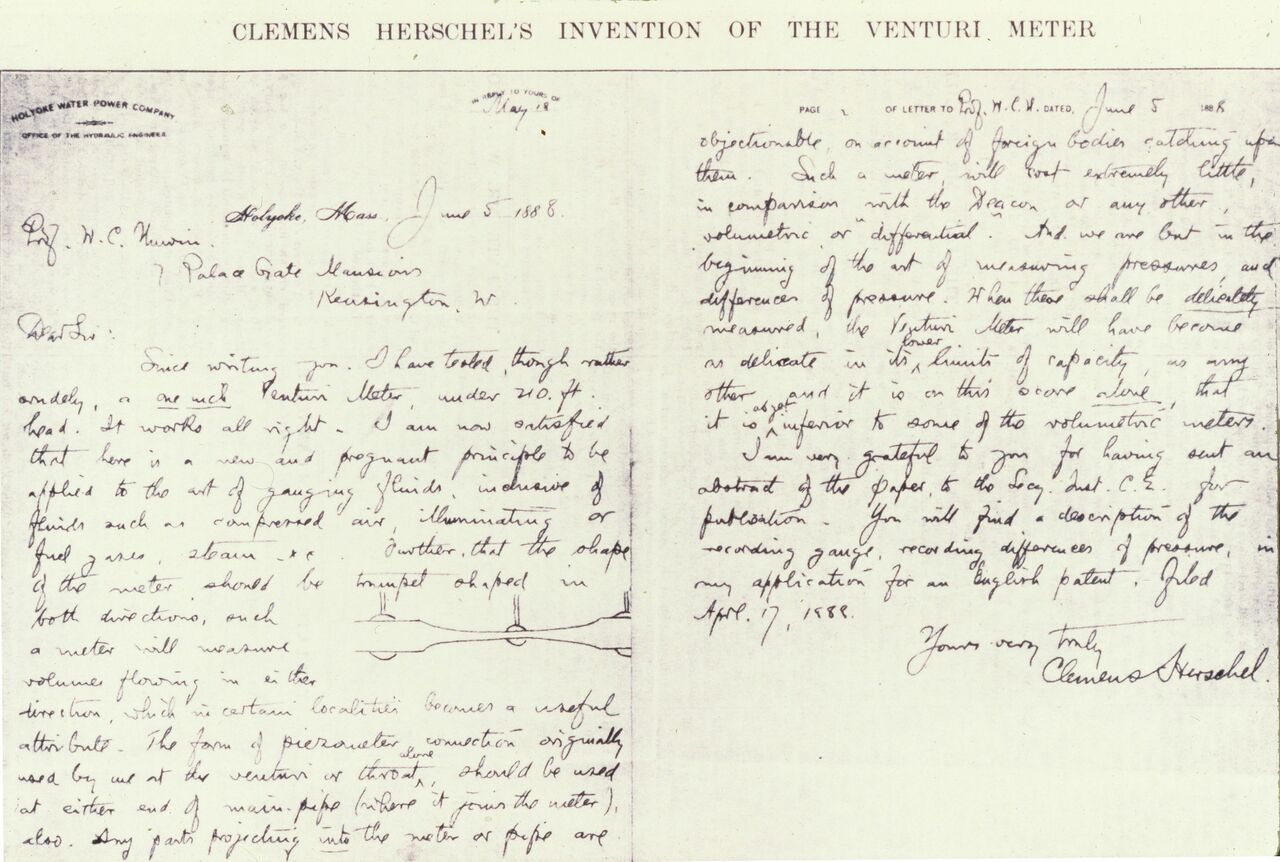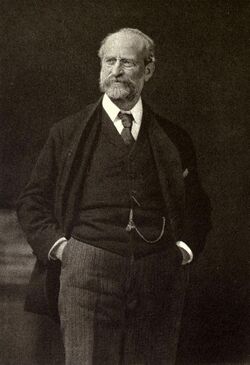
| Version | Summary | Created by | Modification | Content Size | Created at | Operation |
|---|---|---|---|---|---|---|
| 1 | Conner Chen | -- | 965 | 2022-11-24 01:34:35 |
Video Upload Options
1. Introduction
Clemens Herschel (March 23, 1842 – March 1, 1930) was an American hydraulic engineer. His career extended from about 1860 to 1930, and he is best known for developing the Venturi meter, which was the first large-scale, accurate device for measuring water flow.[1][2]
2. Early Life and Education
Clemens was born in Vienna in 1842. His family immigrated to Davenport, Iowa in 1850. He spent most of his life practicing his profession in Massachusetts, New York and New Jersey. He attended Harvard University, where he received his bachelor of science degree in 1860 from the Lawrence Scientific School.[3][4] After Harvard, he completed post-graduate studies in France and Germany.[5]
3. Career

The first part of Herschel's career was devoted to bridge design, including the design of cast-iron bridges. For a time, he was employed on the sewerage system of Boston.[3] Herschel was influenced by James B. Francis, who was the agent and engineer of the Proprietors of Locks and Canals on the Merrimack River at Lowell, Massachusetts, to switch his career path to hydraulic engineering.[5] About 1880, he started working for the Holyoke Water Power Company in Massachusetts. He remained with the company until 1889. While he was there, Herschel designed the Holyoke testing flume, which has been said to mark the beginning of the scientific design of water-power wheels.[4] Herschel first tested his Venturi meter concept in 1886 while working for the company, and by 1888 felt he had perfected it conceptually, ultimately naming it in honor of Giovanni Battista Venturi, the eminent Italian physicist who first described the differential pressure phenomenon in a 1797 treatise.[6] The original purpose of the Venturi meter was to measure the amount of water used by the individual water mills in the Holyoke area.[7]

Water supply development in northern New Jersey was an active area of investment in the late 19th century. In 1889, Herschel was hired as the manager and superintendent of the East Jersey Water Company, where he worked until 1900.[5] He was responsible for the development of the Pequannock River water supply for Newark. He also installed two of his largest Venturi meters at Little Falls, New Jersey, on the main stem of the Rockaway River to serve Paterson, Clifton and Jersey City.[8]
After 1900 and lasting until the end of his life, Herschel was a consulting hydraulic engineer with offices in New York City. He worked on some of the major water development projects in the world. He played a major part in the construction of the hydroelectric power plant at Niagara Falls, which was the first large-scale electric power plant. He was appointed to an expert committee that reviewed the plans for the first water tunnel that would deliver water from the Catskill reservoirs to New York City.[4][5]
4. Personal Life
Herschel's first wife, Grace Hobart, died in 1898.[4] They had three children, Arthur, Winslow and Clementine. Herschel married Jeannette Begg Hunter of Thompsonville, Connecticut, on March 5, 1910. They had one son, Clemens Herschel Jr.[4][9]
5. Professional Associations
Herschel was active in several professional organizations including the American Water Works Association and the New England Water Works Association. He was a member of the Institution of Civil Engineers in London, and he was elected president of the American Society of Civil Engineers in 1916.[4]
6. Honors and Awards
Herschel was one of the first five inductees into the American Water Works Association Water Industry Hall of Fame. He was also made an honorary member of that organization.[10] Herschel was awarded the Elliott Cresson medal in 1889 by the Franklin Institute for his development of the Venturi water meter.[4][5]
In 1888, Herschel was presented with the Thomas Fitch Rowland Prize by the American Society of Civil Engineers. The Rowland Prize is awarded to an author whose paper describes in detail accomplished works of construction or which are valuable contributions to construction management and construction engineering.[11] He was made an Honorary Member of ASCE in 1922.
The Clemens Herschel Prize was established at Harvard University in 1929. The award is given to meritorious students in practical hydraulics.[12] Each year, the Boston Society of Civil Engineers Section presents the Clemens Herschel Award to authors "…who have published papers that have been useful, commendable, and worthy of grateful acknowledgment."[13]
7. Publications
Perhaps Herschel's most well-known publication was not a strictly technical book. While traveling in Italy in 1898, he found a manuscript written by Sextus Julius Frontinus, who was the designer of the water supply system of ancient Rome.[14] He translated the work into English and entitled it Frontinus and the Water Supply of the City of Rome. Other more recent translations have been done by scholars and Latin specialists, but Herschel's book brought the challenges and successes of the water commissioner for Rome to the notice of water professionals.[4][14]
Some of his other publications include:
- Herschel, Clemens (1897) 115 Experiments on the Carrying Capacity of Large, Riveted, Metal Conduits, up to Six Feet per Second of Velocity of Flow New York:Wiley
- Herschel, Clemens (1898) Measuring Water Providence, RI:Builders Iron Foundry
- Herschel, Clemens (1899) The Venturi Water Meter Reprinted from Cassier's Magazine
- Herschel, Clemens (1893) “The Works of the East Jersey Water Company, for the Supply of Newark, New Jersey” Journal of the New England Water Works Association 8:(September): 19–39
- Herschel, Clemens (1926) “Water Supply and Main Drainage Districts” Journal AWWA 16:5 531–541
References
- Herschel, Clemens, "Apparatus for measuring the quantity of water flowing through a pipe," U.S. Letters Patent no. 381,373 (filed: 1887 December 12 ; issued: 1888 April 17). http://pdfpiw.uspto.gov/.piw?docid=00381373&PageNum=1
- "Invention of the Venturi Meter". Nature 136: 254. August 17, 1935. doi:10.1038/136254a0. https://www.nature.com/articles/136254a0. Retrieved May 15, 2018. "[The article] reproduces a letter from Herschel to the late Dr. Unwin describing his invention of the Venturi Meter. The letter is dated June 5, 1888, and addressed from the hydraulic engineer's office of the Holyoke Water Power Co., Mass. In his letter, Herschel says he tested a one-inch Venturi Meter, under 210 ft. head: 'I am now satisfied that here is a new and pregnant principle to be applied to the art of gauging fluids, inclusive of fluids such as compressed air, illuminating or fuel gases, steam, etc. Further, that the shape of the meter should be trumpet-shaped in both directions; such a meter will measure volumes flowing in either direction, which in certain localities becomes a useful attribute...'".
- New York Times. "Clemens Herschel Dies in 89th Year." March 3, 1930
- "Clemens Herschel." (1930). Journal AWWA. 22:5 685-6.
- Kent, Walter G. (1927). An Appreciation of Two Great Works in Hydraulics, Giovanni Battista Venturi, born 1746, Clemens Herschel, born 1842. London: Blades, East & Blades.
- "Invention of the Venturi Meter". Nature 136 (3433): 254. August 17, 1935. doi:10.1038/136254a0. Bibcode: 1935Natur.136Q.254.. https://www.nature.com/articles/136254a0. Retrieved May 15, 2018. "[The article] reproduces a letter from Herschel to the late Dr. Unwin describing his invention of the Venturi Meter. The letter is dated June 5, 1888, and addressed from the hydraulic engineer's office of the Holyoke Water Power Co., Mass. In his letter, Herschel says he tested a one-inch Venturi Meter, under 210 ft. head: 'I am now satisfied that here is a new and pregnant principle to be applied to the art of gauging fluids, inclusive of fluids such as compressed air, illuminating or fuel gases, steam, etc. Further, that the shape of the meter should be trumpet-shaped in both directions; such a meter will measure volumes flowing in either direction, which in certain localities becomes a useful attribute...'".
- #129 Holyoke Water Power System (1859). Retrieved December 18, 2012. http://www.asme.org/about-asme/history/landmarks/topics-m-z/mechanical-power-production-water/-129-holyoke-water-power-system-(1859)
- McGuire, Michael J. (2013). The Chlorine Revolution: Water Disinfection and the Fight to Save Lives. Denver, CO:American Water Works Association, Chapter 11.
- New York Times. “Clemens Herschel Weds.” March 6, 1910.
- AWWA Water Industry Hall of Fame, American Water Works Association. Retrieved December 16, 2012. http://www.awwa.org/Membership/awards.cfm?ItemNumber=57395
- Rowland Past Award Winners http://www.asce.org/Content.aspx?id=17482
- Clemens Herschel Prize Harvard University Prize Office. Retrieved December 12, 2012. http://prizes.fas.harvard.edu/icb/icb.do?keyword=k78478&pageid=icb.page401491#a_icb_pagecontent850565_herschel
- BSCES Individual Section Awards http://www.bsces.org/bsces/file/2012%20Individual%20Section%20Awards%20Nomination%20Form%20(rev).pdf
- Frontinus, Sextus Julius. (1973). The Water Supply of the City of Rome of Sextus Julius Frontinus Water Commissioner of the City of Rome A.D. 97. Translated by Clemens Herschel, Boston: New England Water Works Association.

Location: Boston, Massachusetts




